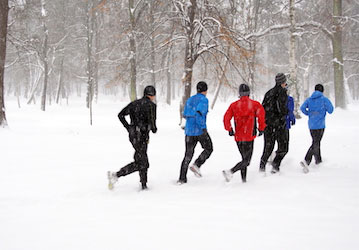You can face many obstacles to keeping your fitness levels up during winter. The stress of the holidays, the long, dark days, and holiday parties that challenge your diet plans can be quite the burden. Winter can also bring the “winter blues,” where people display symptoms of depression, or the more severe Seasonal Affective Disorder, which is a form of depression that starts in the fall or winter and stops as spring weather sets in.
Being active is a great strategy to offset the ill-effects of winter. Here are some tips for an outdoor workout if an indoor gym isn’t for you.
- Grab the shovel. Shoveling snow can be a great workout, even if you’re in good shape. Snow ranges from light and fluffy to wet and heavy, which can be a good mix for cardio training. In fact, shoveling snow has been shown to work your cardiovascular system as hard as a VO2max test—which is incredibly difficult. When you lift the shovel, it’s important to use the right technique—essentially a deadlift—so you don’t hurt your back.
WARNING: Shoveling snow has been linked to increased rates of heart attack and sudden cardiac arrest. If you don’t exercise regularly, you’re middle age or older, or you have any heart conditions, see your doctor before shoveling.
- Shovel, lunge, squat. Do deadlifts, lunges, and squats all in one circuit. Deadlift the full shovel up, throw the snow into the pile, then raise your shovel overhead to perform an overhead lunge and overhead squat. Repeat the pattern until your path is clear of snow. For the lunges and squats, avoid pressing the full shovel overhead. The weight won’t be balanced on both ends as it’s on a normal barbell. Plus, you could end up with a shovelful of snow on your head or the back of your neck! Although bodyweight exercises aren’t as effective for building strength as weighted exercises, they’re great for technique and body control.
- Snowball push. You’ve heard of the snowball effect, where something starts small and “snowballs” as you move forward. Start with a small snowball, and roll it across the ground. As it gets bigger, it’ll get heavier and become more difficult to push. Roll the ball uphill for added difficulty. For more tips, watch HPRC’s video on pushing objects.
- Running hills. Challenge yourself, a friend, or your kids to race up a snowy hill. The added resistance from the snow will give you a great cardio workout, on top of a regular hill session. Try to stick to familiar hills so you know where to avoid holes or other snow-covered hazards. This is a great activity to do with your kids when you go sledding.
To prevent cold injuries when you go outside for a winter workout, here are a few precautions.
- Dress in layers. Choose synthetic materials—such as polyester or polypropylene—that stay close to the skin. Avoid cotton since it soaks up and holds onto sweat, which keeps your skin wet. As you warm up, you always can remove layers.
- Protect your fingers, toes, and ears. Circulation to these areas decreases in cold weather in order to keep your core warm. Wear gloves, thick socks, and a hat. Chemical heat warmers also help in very cold conditions.
- Warm up. Perform a dynamic warm up before you head outdoors. This will help warm up your muscles and body, so it might feel like less of a shock when you step outside. It will also help reduce your risk for injuries as you work out.
- Check the forecast. Wind chill, snow, and rain can make you more vulnerable to the outside temperatures. Plan an indoor workout when the temperature drops below 0°F or when the wind chill brings the temperature down below zero. The risk for hypothermia and frostbite isn’t worth the benefits of going outside.
- Stay hydrated. When you exercise in cold climates, don’t rely on thirst to indicate your need for hydration—you usually don’t feel as thirsty in cold temperatures. The low humidity in the winter allows your sweat to evaporate quickly, and you might not realize just how much you are sweating. Dehydration in the winter can also increase your risk for cold injury.
- Be visible. With fewer hours of sunlight in the winter, you might go for a walk or run when it’s dark out—even at dusk and dawn. Wear a headlamp to stay visible to oncoming traffic, and don’t forget your high-vis reflective belt!
